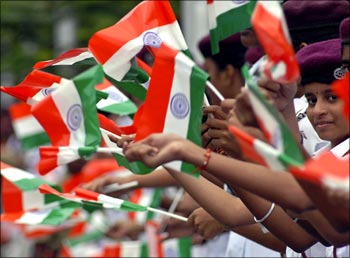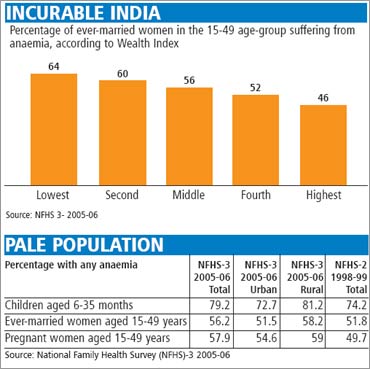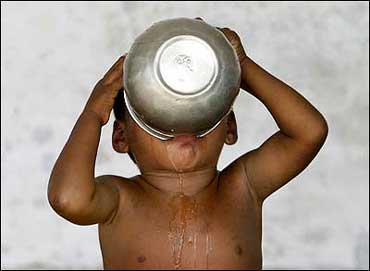
Anaemia is one of India's most serious health concerns with almost half the children below the age of five suffering from moderate to severe anaemia.
What is more staggering is the fact that the incidence of moderate to severe anaemia in children is less than 25 per cent in just four states -- Manipur, Goa, Mizoram and Kerala. While Rajasthan, Punjab and Haryana have the highest prevalence of severe anaemia in children, Bihar, Chhattisgarh and Uttar Pradesh have the highest incidence of moderate anaemia among children.
Anaemia is also a concern among women of all groups and since it results from an interplay of multiple factors -- nutritional deficiencies, infectious diseases like hookworm and malaria -- it is difficult to pinpoint why one state is worse off than the other.
What is clear, though, is that the prevalence of anaemia is an important measure of health. Its pervasiveness across India, across all income groups points to the low health levels of the Indian population.
. . .

Why is this important? Anaemia is significantly related to mortality and productivity. During pregnancy, it not only leads to maternal complications but also affects infant health and mortality by causing low birth weight and lowered immunity to infections.
According to the Indian Medical Association, anaemia is one of the leading causes of school dropouts and results in lower mental and motor development, fatigue and low productivity in adulthood. There are various estimates of the impact on GDP; according to The Micronutrient Initiative, India loses 1.27 per cent of its GDP annually due to anaemia.
The Indian Medical Association goes with a figure closer to 4 per cent of GDP, which includes the effect of learning and motor impairment in anaemic children.
. . .

Despite a national programme to control anaemia since the seventies, there has been negligible progress. In fact, between 1998-99 and 2005-06, the incidence of anaemia actually increased in India.
In 2007, the 12X12 initiative was launched to tackle iron deficiency on a war footing, with support from the central government, the Indian Council of Medical Research, the World Health Organisation, Unisef, the Federation of Obstetrics, the Gynaecological Societies of India and so on.
The programme works in coordination with existing government schemes and aims at achieving haemoglobin levels of 12 g/dl by the age of 12 years by 2012. It covers all aspects that impact anaemia -- capacity building, health and nutrition education, increasing iron intake, weekly supplementation with iron folic acid tablets, parasite control through periodic de-worming and appropriate immunisation.
. . .

Though there is no country-wide data as yet to gauge the effectiveness of this programme, there are many projects that have picked up on the ground.
For instance, Bihar took up the Micronutrient Initiative's Nutri-candy programme on a priority basis in 2006, as a public private partnership, pushed by the chief minister.
However, nutritional supplements form just one part of the solution; hygiene and sanitation are equally crucial. An improvement in the access to good water supply and sanitation facilities all across the country is key to a healthier and more productive population.
Indian States Development Scorecard is a weekly feature by Indicus Analytics that focuses on the progress in India and the states across various socio-economic parameters.